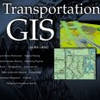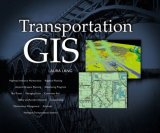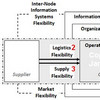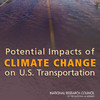 Roads are main arteries of modern society’s infrastructure, contributing heavily to the distribution of goods and persons. GIS provides many helpful applications for ensuring a smooth flow, by aiding design, routing, traffic control and real-time navigation. In essence, a GIS application in transportation is maybe no longer a GIS, but a merger of GIS with Intelligent Transportation Systems or Transport Telematics, where GIS no longer exists as a stand-alone product. This essay will attempt to display the extent of existing GIS applications within road transportation, and critically assess their appropriateness and potential.
Roads are main arteries of modern society’s infrastructure, contributing heavily to the distribution of goods and persons. GIS provides many helpful applications for ensuring a smooth flow, by aiding design, routing, traffic control and real-time navigation. In essence, a GIS application in transportation is maybe no longer a GIS, but a merger of GIS with Intelligent Transportation Systems or Transport Telematics, where GIS no longer exists as a stand-alone product. This essay will attempt to display the extent of existing GIS applications within road transportation, and critically assess their appropriateness and potential.
Introduction
Using GIS in the field of transportation opens up a wide range of possible applications, as diverse as the field of transportation itself. Whether these are cars and trucks along a road, trains along a track, ships across the sea or airplanes in the sky, all applications have one thing in common: They are objects that move along a path in space. A GIS can provide a valuable tool for managing these objects in a spatially referenced context, viewing the paths as a transportation network.
Planning and design
GIS provides a valuable tool in the process of planning and designing roads. This is closely related to the term Computer Aided Design (CAD), but it is hard to tell at what level of detail CAD stops and where GIS actually begins. Modern software (e.g. Bentley’s Microstation) tends to bridge this gap between discipline-specific applications and GIS in a way that they are fully integrated.
A GIS can help visualise and communicate the effects of roads on their environment. Engineering drawings and maps may evoke a vivid landscape in minds of engineers familiar with them, but to decision makers or the public in general these drawings can be quite incomprehensible. Traditionally, displaying different route options and proposals has been done in the form of 2D maps, assisted by section drawings, maybe together with an aerial photo, where the road network was overlaid in the form of lines. It is simple and straightforward, but it is not conveying much information on the actual impact.
Therefore, the UK Highways Agency has taken on building virtual showrooms, presenting the road by displaying a 3D drive-through along a highway or a bird’s eye view of the landscape from any angle the user wants to hover (Sinclair, 1999). This can be presented to a planning board or the public using ordinary PCs, or it can even be published on the Internet for open access to everybody.
The highways agency in the French department de la Loire has been using GIS since 1989 for many purposes: Traffic accident patterns are visualised and safety improvements are made where they are most needed. By collecting significant data for the whole network, repairs and works budgeting have become more reliable and calculated in advance. First creating the optimal route between locations and then using GIS to decide how and where to sign, improved directions and movements in the road network and helped avoiding congestion (Marshall, 1995).
Routing
Euler’s famous “Königsberg bridge” question, dating back as far as 1736, is often seen as the starting point of modern route finding – was it possible to find a route through the city crossing each of its seven bridges once and only once and then returning to the origin? His methods formed the basis of what is now known as graph theory, and paved the way for path finding algorithms that are applied in GIS in the solution of routes in transportation networks (Rimsha, 1996). Hence, in GIS route planning is often referred to as network analysis.
Route planning is one of the most popular applications within transportation, for obvious reasons. Roads are part of the infrastructure that makes up the spinal cord of modern society, but roads can just as easily turn into bottlenecks. Consequently, any business deploying vehicles is interested in determining which route is the best to follow as means to save time and essentially gain the best cost/benefit ratio. This can be used to distribute goods, deliver newspapers or pizza, respond to emergency calls, or to plan your personal travel. There are many ready-made software products available on the market, ranging from simple A-to-B drive time analyses to full-fledged fleet management systems. There are also many online routing applications available on the Internet, allowing travellers to log in, plan their journey and consider different options.
Route planning is also applied as apart of location planning, analysing catchment areas for different sites, calculating overall drive-times to and from site, maximising potential customer inflow and ensuring best possible accessibility. Safeway has successfully implemented GIS for such planning (Fletcher, 1999).
Navigation
Route planning in advance of a journey is one way to enhance transportation management. Using an in-car navigation system is another one, and has been on the market for some time.
Blaupunkt introduced its Travel Pilot as early as in 1989. In 1997, ETAK, a leading provider of digital map data and pioneer in navigation software, released a map database providing turn-by-turn vehicle navigation throughout mainland Great Britain. Used in conjunction with GPS this system not only is an in-car route finder, but also provides the driver with detailed instructions on where to turn in what direction. It also contains a lot of information on points of interest a driver might want to know. The road data itself derives most in most cases from Ordnance Surveys OSCAR product family, which is then used by different manufacturers in conjunction with their own system.
Tracking
Not only is finding the best way from A to B of importance to vehicle drivers or the company who deploys them. To keep track of where the vehicle is at any given moment of time is equally, if not even more crucial, in efficient fleet management. Tracking and monitoring of vehicle movements emerged with the advances in mobile communication (GSM) and satellite navigation (GPS). The position of a vehicle is monitored via onboard GPS, transmitted back to a base via GSM, and loaded into a GIS where it can be displayed on map.
Already in 1995, Oslo Taxi of Oslo, Norway, fully automated the monitoring of its entire fleet (Baumann, 1995). The exact location of all vehicles is now known at all times by the taxi dispatchers, improving any needed emergency response to the driver and customer response to incoming orders, ensuring that the nearest available taxi is sent to the pickup location.
Around 400,000 vehicles are stolen each year in the UK. With an in-car GPS that continuously relays the car’s position to a control centre, the car can easily be tracked in case it is stolen. In case of an emergency breakdown, help can be dispatched to his or her exact location. (Fitzgibbon, 1999).
Traffic control
The Highway Agency in the UK and many other countries monitor ongoing traffic at critical points in the road network round-the-clock, using cameras, counting devices or other means of traffic data gathering, and then relaying this information to the public or using it for analytical purposes.
Traffic control systems are among the most demanding of the Intelligent Transportation Systems. They may have to cover large geographical areas and interface with a large number of devices, thus managing data available from a variety of disparate sources, not necessarily in common format. (WS Atkins, 1999) Metronetworks is a private UK company that specialises in relaying traffic information, giving up-to-date real-time traffic information to the public, to be broadcasted via radio or to be displayed on the Internet.
Southampton has implemented a EU-funded project, ROMANSE. In this project, relevant up-to-date traffic and travel information for public and private transport users is posted electronically on touch screen displays at main transport interchanges, shopping centres, tourist information centres and libraries, and also on the Internet./p>
Trafficmaster is a company in the UK that has been going its own way, installing a network of traffic flow sensors along major road arteries, and relaying this information to subscribing motorists via mobile phone or in-car voice device. (Fitzgibbon, 1999)
Evaluation
Using GIS aiding road design has proved itself as useful, especially when visualising impact on the environment is concerned. Conflicts that arise can be seen directly, and different options can be explored more easily than on a paper map. Using GIS for 3D visualisation may also help solving clashes that often occur when different engineering fields work together on a large-scale project. Changes in design can be made before the problem manifests itself on site.
A further development of this application could be for use in simulators for training drivers, similar to simulators already in use for planes and ships, something that could turn out to be especially helpful for emergency vehicle drivers when they are still new to an area.
In all the mentioned applications GIS is a tool for visualising and analysing data. This is historically speaking the generic way of describing a GIS. The data itself has to be compiled and put together in databases that are linked with or resident within the GIS. Looking at future prospects, the potential range of such applications, combined with 3D visualisation, is virtually unlimited.
Route planners are very useful tools in general, but they have limitations. Data that is used in route-planning systems must be extremely accurate. Even though the road network may look fine on screen, it may contain false information that will divert the route from where it should go, such as sending a vehicle the wrong way down a one-way street or using a route that is closed to the public.
The data must be kept up-to-date with the latest status of any particular road in the network. Thus, a GIS for route planning will have to contain a large volume of attribute data, depending on the specific application needs. Users may want to enquire about gradients, height and weight constraints, road works, filling stations, detour options, hotels or other points of interest (Rimscha, 1996). All this has to be updated continuously. This again means cost for the end user. This is not a product you buy once and for all.
Route-planning systems typically either calculate the shortest or the fastest journey, leaving the user to make the choice. In doing this, the system uses algorithms for choosing a particular route. However, some experienced drivers may not take the same route as the system calculates. For inexperienced drivers, on the other side, the system provides much help.
Route planners will often tend to generalize, because variables such as time of day, weather conditions (e.g. sun, rain, fog, ice or snow), type of car used or driver behaviour are usually not implemented, even though they lay heavy influence on driving. Systems may also lack local knowledge a driver has about a certain stretch of a route.
Given the weight that road transport has in distributing goods and personal transport, and given the steadily increasing complexity of road networks, route planners will undoubtedly not cease to exist.
As for in-car navigation systems, European legislation on what may be displayed inside a moving vehicle is rather rigid, only allowing a screen showing a single bold arrow (Schofield, 1996). A full map can only be displayed when the vehicle is still. Voice messaging has no such restrictions. Both visual and audio output have a potential for distracting the driver, which is why the newly revised Highway Code includes an admonition against the careless use of route guidance and navigation systems. Bearing in mind the current debate in Europe over banning the use of mobile phones in cars, in-car navigation may face the same argument.
Tracking systems depend on GPS for finding the exact location of a vehicle. Modern GPS receivers have an accuracy of between 3 and 30 metres in good conditions. Using so-called differential GPS, the accuracy can be increased to a few centimetres. With a moving object, this is more difficult. Curiously enough, none of the manufacturers advertising their navigation systems on the Internet sites that are listed as reference actually mention the accuracy or possible deviation of the system. On large-scale maps this will seldom generate a visual error, even when roads may be slightly displaced on the map to create a clearer distinction between roads or to highlight certain features along the road.
One aspect that needs to be mentioned is the fact that in-car navigation also can serve as a tracking device, leaving behind electronic signals of a vehicle and its whereabouts, adding up just another of the many electronic footprints a person might activate during a day.
The range of products and applications in the transportation sector indicates that these are tools that are in high demand. It has been estimated that some 80% of all information that any business manages has a geographic context (Leslie, 1999). Crucial to any organisation’s success is access to good and valid information. In the field of transportation much of this information is constantly moving, thus increasing the demand for up-to-date information. GIS can help manage this information.
Conclusion
The applications listed have been described as applications of GIS, and may in their consecutive order also be read as how GIS in transportation has developed over time. Looking closer, the latter ones are actually more related to the term transport telematics than to GIS. Transport telematics means the large-scale integration and implementation of telecommunication and informatics technology in the field of transportation, penetrating all areas and modes of transport, the vehicles, the infrastructure, the organisation and management of transport (Wähl, unknown). Transport telematics is also often referred to as being part ITS. Consequently, it is hard to distinguish between GIS and ITS. The more sophisticated an application is, the more seamless the merge is between different integrated systems.
It has been shown that using GIS in transportation calls for very high accuracy on the attribute data of the road network. With the number of different software brands on the market, a careful examination of the provider’s ability to supply and update correct data is important for the success of the application.
It is clear that GIS can be used for a wide range of applications in the transportation sector. Merging GIS with telematics seems to open up a whole new array of possible real-time applications in the transportation sector. What all these applications have in common is that GIS plays a major part, providing the spatial reference, but can the system still be called a GIS application? It may be argued that this system is no longer GIS, but a technology that dissolves GIS into something new. This is probably the largest potential for the future of GIS in transportation: GIS will no longer be a stand-alone product, but fully integrated with other business information systems.
Recommended books
References
Baumann, J. (1995) Guidance from the skies: promoting safety and service with GPS and GIS, GIS Europe, vol. 4, no. 7, pp. 33-35
Belgeonne, E. (1999), Orchid blooms early in transport telematics, Mapping Awareness, vol 13, no 8, pp. 58-60
Fitzgibbon, P. (1999) Intelligent transport systems and navigation, Mapping Awareness, vol 13, no 8, pp. 52-55
Fletcher, S.J. (1999) Geomarketing with Safeway, The Edge, September 1999, pp. 20-22
Haskins, D. (1999) Internet Public Transport Information: The Killer App?, Mapping Awareness, vol. 13, no 8, pp. 56-57
Husdal, J., Sandvik, A. and Klingsheim, A. (1998), PloGIS – et verktøy i forvaltning av bilpark og planlegging av kjørerute (Norwegian, English: PloGIS – a tool in car pool management and route planning),Coursework submitted in fulfillment of the one-year undergraduate study in GIS, Telemark College, Norway
Leslie, S. (1999) The Importance of Being Geographic: why geographic information analysis is critical to the modern organisation, The Edge, September 1999
Marshall, J. (1995) Point de départ: GIS as a driving force in the Loire, GIS Europe, vol. 4, no. 6, pp. x-xiii
McCall, S. (1997) On the Buses, Mapping Awareness, vol. 11, no. 7, pp. 38-39
Rimsha, S.v. (1996) GIS in route and transport planning – a view from Germany, GIS Europe, vol. 5 no. 2, pp. xiv-xvi
Schofield, A. (1996) The new golden age of motoring, Mapping Awareness, vol. 10, no 10, pp. 18-21
Reference
Husdal, J. (1999) Road Transportation Management using GIS – vehicle routing and tracking. Unpublished course paper for the MSc in GIS. University of Leicester, UK.
Related
- husdal.com: Fleet management with GPS
- husdal.com: Book Review: Transportation GIS














